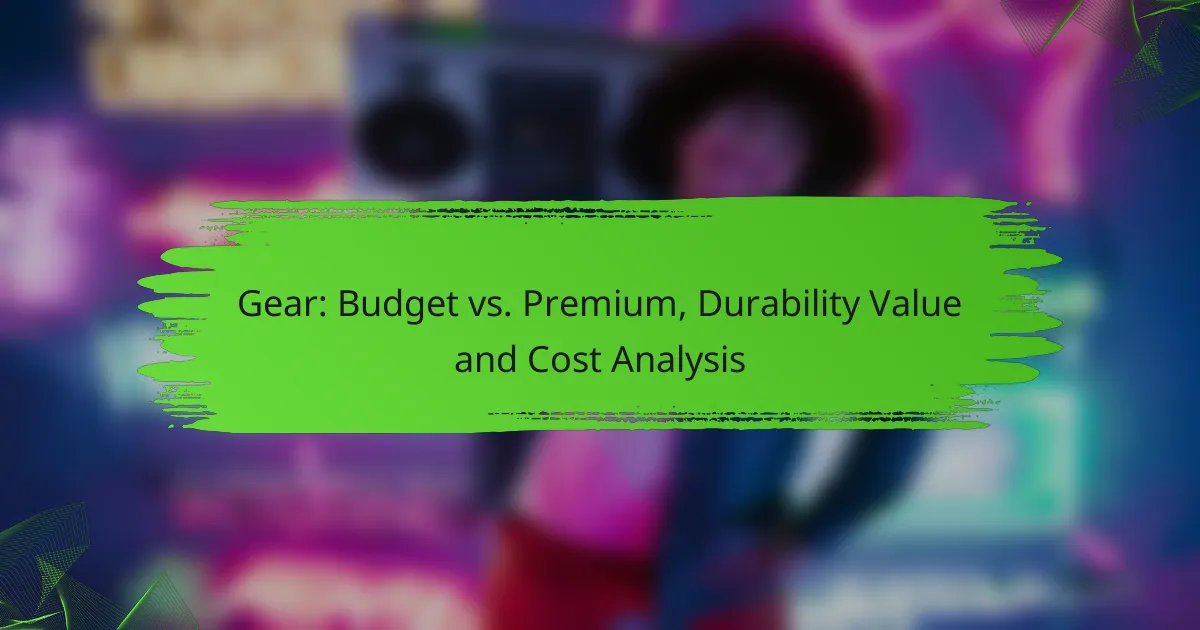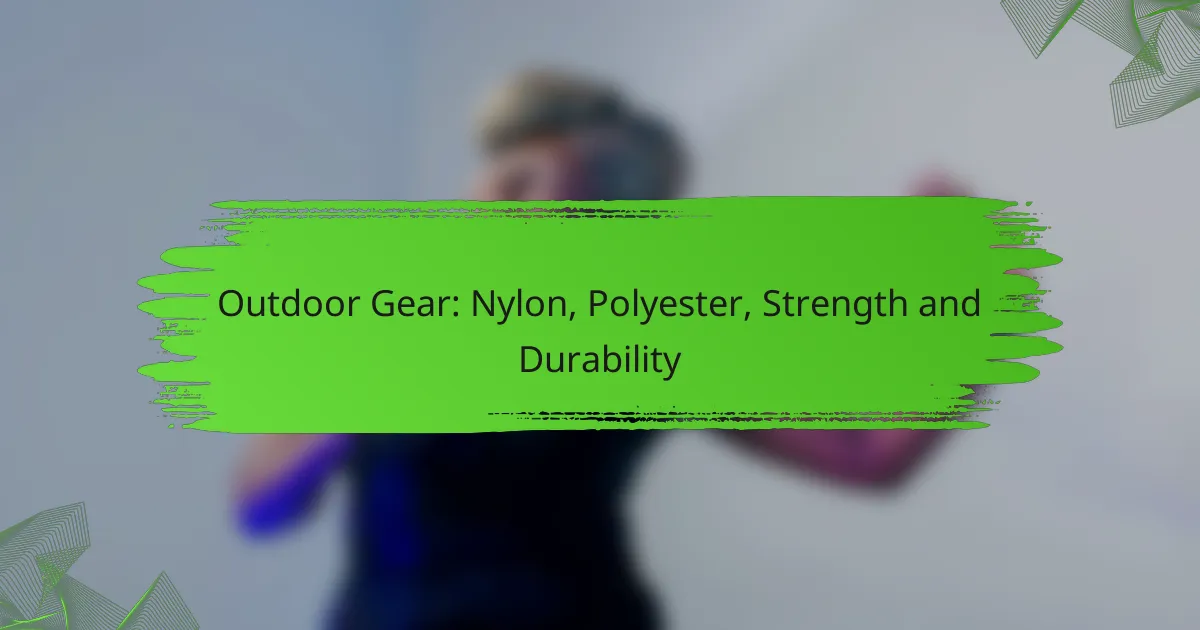When selecting gear, consumers often face the dilemma of choosing between budget and premium options. While budget gear may be more affordable upfront, it typically lacks the durability and longevity found in premium products, which are designed for more demanding use. Understanding the trade-offs between initial costs and long-term value is essential for making an informed decision that aligns with your needs.

How does budget gear compare to premium gear in durability?
Budget gear generally offers lower durability compared to premium gear, which is designed for longevity and resilience. While budget options may suffice for occasional use, premium gear is often a better investment for frequent or demanding applications.
Budget gear typically uses lower-quality materials
Budget gear often incorporates materials that are less durable, such as lower-grade plastics or fabrics. These materials can wear out faster, leading to a shorter lifespan and potentially higher replacement costs over time.
For example, a budget backpack may use thin nylon that tears easily, while a premium version might use ripstop nylon, which is designed to withstand more rigorous use. When evaluating budget gear, consider how often you will use it and whether the lower cost justifies the potential for quicker wear and tear.
Premium gear often features advanced materials for longevity
Premium gear typically utilizes advanced materials that enhance durability, such as high-denier nylon, carbon fiber, or specialized waterproof coatings. These materials are engineered to resist abrasion, moisture, and other environmental factors, ensuring a longer lifespan.
For instance, a premium tent may feature a rainfly made from silicone-coated fabric, which offers superior water resistance compared to standard polyester. Investing in premium gear can reduce the need for frequent replacements, ultimately saving money in the long run.

What are the cost implications of choosing budget vs. premium gear?
Choosing between budget and premium gear involves weighing initial costs against potential long-term value. Budget gear typically has lower upfront costs, while premium gear may provide enhanced durability and performance, leading to better value over time.
Budget gear has lower upfront costs
Budget gear is often more accessible, appealing to those with limited funds or who are new to a particular activity. Prices can range from low tens to a few hundred dollars, making it easier to get started without a significant financial commitment.
However, while budget options save money initially, they may lack durability and features found in premium gear. Users should consider how frequently they will use the gear and whether the lower price justifies potential replacements or repairs in the future.
Premium gear may offer better long-term value
Investing in premium gear often means higher initial costs, typically starting from a few hundred dollars and going up significantly. This investment can lead to better performance, enhanced features, and greater durability, which can save money in the long run.
Premium gear is designed to withstand rigorous use and often comes with warranties or guarantees. Users should evaluate their long-term needs and usage patterns to determine if the higher upfront cost will ultimately provide better value through longevity and reliability.

What factors influence the durability of gear?
The durability of gear is primarily influenced by the materials used, the design, and the construction methods. Understanding these factors can help consumers make informed decisions when choosing between budget and premium options.
Material quality significantly affects durability
The type of materials used in gear plays a crucial role in its longevity. High-quality materials, such as reinforced nylon or aerospace-grade aluminum, typically offer better resistance to wear and tear compared to lower-grade alternatives. For example, a backpack made from 1000D Cordura fabric will generally outlast one made from 500D fabric.
When assessing material quality, consider factors like abrasion resistance, water resistance, and weight. Investing in gear made from superior materials can lead to savings in the long run, as it may require less frequent replacement.
Design and construction impact overall lifespan
The design and construction of gear can significantly influence its durability. Well-designed gear often incorporates features that enhance strength and functionality, such as reinforced stitching and ergonomic shapes. For instance, a tent with a geodesic design is typically more stable and durable in harsh weather conditions than a standard dome tent.
Additionally, the manufacturing process matters. Gear produced under strict quality control standards is likely to have fewer defects and a longer lifespan. Look for brands that emphasize craftsmanship and offer warranties, as these can be indicators of durability.

How can consumers assess the value of gear?
Consumers can assess the value of gear by evaluating its durability, warranty, and customer feedback. Understanding these factors helps in making informed purchasing decisions that balance cost and longevity.
Comparing warranty offerings provides insights
Warranties serve as a key indicator of a product’s expected lifespan and the manufacturer’s confidence in its durability. A longer warranty often suggests that the gear is built to last, while shorter warranties may indicate potential weaknesses.
When comparing gear, look for warranties that cover a range of years, typically from one to several, depending on the product type. For example, outdoor gear may have warranties lasting from two to five years, while electronics might offer one to three years of coverage.
Customer reviews highlight real-world durability
Customer reviews provide valuable insights into how gear performs under actual usage conditions. Reading about others’ experiences can reveal potential issues that may not be apparent from product descriptions alone.
Pay attention to reviews that mention durability, especially those that discuss long-term use. Look for patterns in feedback; if multiple users report similar problems, it may indicate a common flaw. Aim for products with a high percentage of positive reviews, ideally above 70%, to ensure reliability.

What are the best brands for budget gear?
Some of the best brands for budget gear include Decathlon and AmazonBasics, which offer a range of affordable options without compromising too much on quality. These brands cater to various needs, making them ideal for those looking to save money while still getting reliable equipment.
Decathlon offers affordable options
Decathlon is known for its extensive selection of sports and outdoor gear at competitive prices. Their products often feature good durability and functionality, making them suitable for casual users and beginners. You can find items like hiking boots, camping equipment, and fitness gear, typically priced between $10 and $100.
When shopping at Decathlon, consider their in-house brands, such as Quechua for hiking and camping, and Domyos for fitness. These brands provide a solid balance of quality and affordability, often outperforming other budget options in terms of longevity.
AmazonBasics provides budget-friendly gear
AmazonBasics is a reliable choice for budget-friendly gear across various categories, including electronics, home goods, and outdoor equipment. Their products are generally well-reviewed for their value, often costing significantly less than branded alternatives while still meeting basic functionality.
For instance, you can find items like backpacks, cables, and kitchen tools priced around $10 to $50. While AmazonBasics may not offer the same level of durability as premium brands, they are a great option for those who need affordable solutions without frequent replacements.

What are the best brands for premium gear?
The best brands for premium gear are recognized for their exceptional quality, durability, and performance. Brands like Patagonia and The North Face stand out in the outdoor gear market, offering products that often justify their higher price tags through superior materials and craftsmanship.
Patagonia is known for high-quality outdoor gear
Patagonia has built a reputation for producing high-quality outdoor gear that emphasizes sustainability and ethical manufacturing. Their products often feature advanced materials designed to withstand harsh conditions while minimizing environmental impact.
When considering Patagonia gear, look for items like their jackets and fleece, which are known for their durability and comfort. While prices can be higher, many users find that the longevity of the products makes them a worthwhile investment.
The North Face offers durable premium options
The North Face is another leading brand in the premium gear category, known for its durable and reliable outdoor equipment. Their range includes everything from technical jackets to sleeping bags, all designed to perform well in extreme conditions.
For those seeking high-performance gear, The North Face often incorporates innovative technologies such as waterproofing and insulation. Although their products can be on the pricier side, the durability and effectiveness often make them a preferred choice for serious outdoor enthusiasts.

How does location affect gear durability?
Location significantly influences gear durability due to variations in climate and regional activities. Different environments can accelerate wear and tear on materials, while specific outdoor pursuits may require gear designed to withstand local conditions.
Different climates impact material performance
Climates can vary widely, affecting how materials perform over time. For instance, gear used in humid areas may be prone to mold and corrosion, while equipment in arid regions might suffer from cracking due to dryness. It’s essential to choose materials that are suited for the specific climate where the gear will be used.
Common materials include nylon and polyester for water resistance, while breathable fabrics like Gore-Tex are ideal for wet climates. When selecting gear, consider the average temperature range and humidity levels to ensure durability.
Regional activities influence gear requirements
The activities prevalent in a region dictate the type of gear needed, which in turn affects durability. For example, hiking in mountainous areas requires sturdy footwear and weather-resistant clothing, while coastal activities may necessitate saltwater-resistant materials. Understanding local activities helps in selecting gear that can endure specific stresses.
Additionally, some regions may have regulations regarding gear standards, especially for safety equipment. Always check local guidelines to ensure compliance and durability in your gear choices.

What is the lifecycle of budget vs. premium gear?
The lifecycle of budget and premium gear varies significantly in terms of durability, performance, and overall value. Budget gear typically has a shorter lifespan and may require more frequent replacements, while premium gear is designed for longevity and often provides better performance over time.
Durability of Budget Gear
Budget gear is generally made from lower-quality materials, which can lead to quicker wear and tear. Users can expect a lifespan ranging from a few months to a couple of years, depending on usage and maintenance. For instance, a budget tent may last one camping season, while a premium model could endure for several years.
When considering budget options, look for user reviews that mention durability and performance. Avoid gear that seems overly lightweight or flimsy, as these are often indicators of reduced longevity.
Durability of Premium Gear
Premium gear is constructed with high-quality materials and advanced manufacturing processes, resulting in enhanced durability. This gear can last several years, often with warranties that reflect the manufacturer’s confidence in their products. For example, premium backpacks may come with lifetime warranties, indicating their expected longevity.
Investing in premium gear often means fewer replacements and repairs over time, which can lead to cost savings in the long run. Consider the total cost of ownership, including maintenance and replacement costs, when evaluating your options.
Value Considerations
Value in gear is not solely about the initial purchase price; it encompasses durability, performance, and long-term satisfaction. While budget gear may seem appealing due to its lower cost, the need for frequent replacements can diminish its overall value. Premium gear, although more expensive upfront, often provides better performance and longevity.
When assessing value, consider how often you plan to use the gear and the conditions it will face. If you’re an occasional user, budget gear might suffice, but for regular use in challenging conditions, premium gear is usually the better investment.
Cost Analysis
Cost analysis involves comparing the initial purchase price against the expected lifespan and performance of the gear. Budget gear may cost significantly less, but if it needs to be replaced frequently, the total expenditure can add up quickly. Premium gear, while higher in upfront cost, often proves more economical over time due to its durability.
To make an informed decision, calculate the cost per use by dividing the total cost of the gear by its expected lifespan in years. This can help clarify whether a budget or premium option offers better financial sense for your specific needs.



